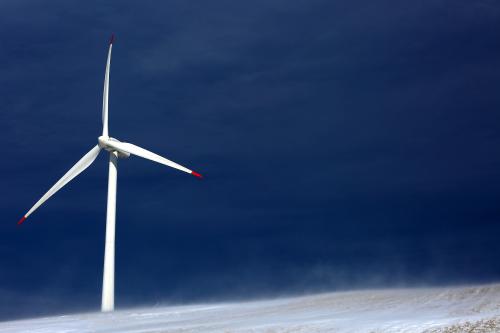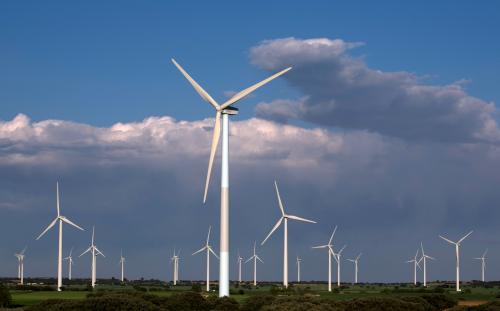Last week we showed how, despite important momentum, America’s clean energy innovation ecosystem—as measured by technology patenting—faces a critical juncture. Just when our data suggests inventiveness in the sector may be slowing, the Trump administration has proposed harsh cuts to federal clean-energy R&D programs that could be deeply unhelpful to low-carbon technology innovation.
Will the U.S. dominate the emerging energy storage industry? What about the offshore wind industry, which has the potential to generate twice the country’s present electricity needs, or smaller, cheaper, and safer nuclear reactors? Maybe the cleantech future won’t be as bright as it sometimes seems.

Which is why it now falls principally on Congress to maintain America’s leadership in clean energy innovation.
At issue here is the adequacy of the nation’s low-carbon technology investments which—while supported by states and localities and committed business leaders rely heavily on the federal government.
The emergence of breakthrough low-carbon technologies, whether the cheapest, most efficient solar modules or the coolest electric vehicle advances, depends significantly on basic and applied research funded in large part through the Department of Energy (DOE) and conducted at U.S. national labs, universities, and research institutions. At the same time, the department’s commercialization programs such as the Loan Guarantee program play a large role in helping to ensure that new technology makes it out of the lab and into the marketplace where it can drive job creation and economic development.
However, all of this is threatened under Trump’s March “skinny budget.” The DOE’s Office of Science would fully lose $900 million of its $5 billion annual appropriation under the Trump outline, with negative impacts on DOE offices supervising early-stage research into solar, wind, nuclear, battery, and carbon capture technologies. Additional cuts would affect all of the agency’s applied energy offices, while at the same time, the Trump framework proposes eliminating ARPA-E, which supports early stage “moon shots” that are too risky for private investment. Also slated for elimination are the loan programs, such as the Advanced Technology Vehicle Manufacturing Program that provided critical early support to Tesla, the auto and energy company now worth $50 billion.
Hence the present faceoff: While the White House has had its say, it is far from clear that Congress will go along with the “skinny” budget. Moreover, given the degree of bipartisan support that energy innovation has tended to enjoy among especially key senators, Congress has the opportunity now to coalesce around a short list of minimum viable budget supports for clean energy sufficient to maintain momentum.
What might this minimum viable product of the budget process look like? A number of core elements of such an outcome can be envisioned, despite the ugly ratcheting down of the discretionary budget.
Little hope remains, for example, that the United States will double its clean energy R&D funding over the next five years, consistent with the international Mission Innovation commitment. And yet, clean energy R&D remains a point of possible convergence in Congress, given that government-funded R&D has long been recognized for playing a critical role in innovation. Accordingly, it is appropriate to challenge members to maintain clean energy R&D appropriations at their current level. Such a commitment would set right one of the skinny budget’s most troubling threats to the ability of firms, industries, and regions to maintain their competitive advantages and develop new ones. This should be understood as a matter of national competitiveness at a time of possible slippage.
Beyond that, though, Congress will surely want to set aside Trump’s wholesale budget cuts in favor of an approach that reforms programs that do not work effectively and scales up those that have shown promise. Several priorities for triage suggest themselves.
For one thing, Congress should move to maximize the economic impact of the nation’s 17 national laboratories, which are a critical part of America’s clean energy ecosystem, as recent Brookings work has suggested. On this front, preserving the DOE Office of Science budget, which supports work at the labs, will be a starting point. But it will also be important to support greater lab autonomy, more collaboration with external small and medium-sized businesses, and better connections with local industrial clusters, including on cleantech deployment. Such adjustments will be important both to contribute to and leverage the power of local strengths and local clusters. In a similar fashion, Congress should also support DOE’s Office of Technology Transitions and Lab to Market initiative, which seeks to amplify the national labs’ impact by supporting the transition of innovative clean technologies into the market. These programs support cost-effective development of next-generation technologies, from conventional to nuclear to renewables, and fit in well with the Trump administration’s “all of the above” energy strategy. But, they also will leverage the “bottom-up” commercial power of local business concentrations.
In addition, Congress should preserve other programs at the DOE that have proved effective at accelerating the deployment and commercialization of technology—again with an eye toward seeding national and local energy innovation networks. Most notably, Congress should preserve the Advanced Research Projects Agency-Energy (ARPA-E), which funds long-shot research with a potential for major commercial impact, has supported entrepreneurs who have gone on to raise more than $1.25 billion in follow-on funding from private investors and create hundreds of jobs. Similarly, Congress should maintain and scale up the energy-focused institutes within the Manufacturing USA network. These programs are helping to move new technologies into the economy, often by ushering them into local low-carbon innovation clusters, and likewise they support a broader manufacturing competitiveness agenda.
In sum, Congress needs to stand up for past and future progress. Yes, it goes without saying that states and regions—and companies—will also need to step up. But even so, key locus of cleantech innovation policy remains federal—and stands at a critical juncture this year.
Now is the time for Congress to mitigate the worst provisions of the “skinny budget” and coalesce around a set of minimum viable supports for low-carbon innovation and growth.
The Brookings Institution is committed to quality, independence, and impact.
We are supported by a diverse array of funders. In line with our values and policies, each Brookings publication represents the sole views of its author(s).







Commentary
Congress faces big juncture on clean energy innovation
May 1, 2017